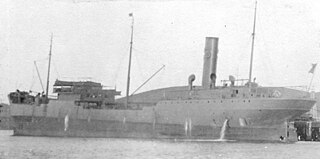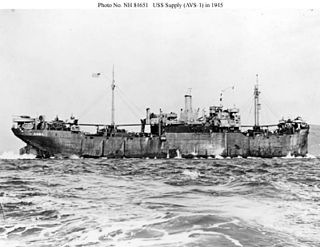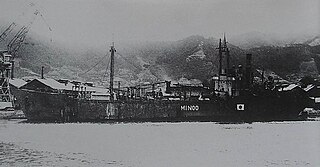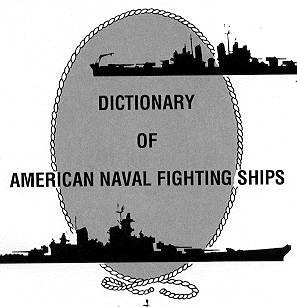
The second USS Abarenda (IX-131) was a storage tanker, one of many miscellaneous-class Navy vessel manned by the United States Coast Guard during World War II.

USS Brooks (DD-232/APD-10) was a Clemson-class destroyer in the United States Navy during World War II. She was named for Lieutenant John Brooks, Jr.
USS General J. H. McRae (AP-149) was a General G. O. Squier-class transport ship built for the United States Maritime Commission during World War II. In 1946 she was transferred to the US Army and operated as USAT General J. H. McRae. On 1 March 1950 she was transferred to Military Sea Transportation Service and operated as USNS General J. H. McRae (T-AP-149). She was named for US Army Major General James H. McRae.
USS Thaddeus Parker (DE-369) was a John C. Butler-class destroyer escort acquired by the U.S. Navy during World War II. The primary purpose of the destroyer escort was to escort and protect ships in convoy, in addition to other tasks as assigned, such as patrol or radar picket. Post-war, she returned home proudly with one battle star to her credit.
The third USS Curlew (AM-69/IX-170) was a Catbird-class minesweeper in the United States Navy during World War II.
USS Nausett (IX–190) was a tanker serving as an auxiliary ship in the United States Navy during World War II. Built as W. M. Irish the ship was a commercial tanker until taken by the War Shipping Administration (WSA) during World War II. WSA first allocated the ship to the Army and then as lend lease to the Soviet Union where the ship was renamed Moskva. On return the ship was renamed Nausett and allocated to the Navy which first accepted the vessel and then found it too expensive to make suitable. The ship was returned to WSA, placed in reserve and sold for scrap the next year.
USS Catbird (AM-68) was the lead ship of her class of two naval trawlers, which were operated as minesweepers by the United States Navy during World War II.

USS Linnet (AM-76), was a Kite-class minesweeper of the United States Navy during World War II.
USS LSM-135 was a LSM-1-class landing ship medium built for the United States Navy during World War II. Like many of her class, she was not named and is properly referred to by her hull designation.

USS Prowess (AM-280) was an Admirable-class minesweeper built for the United States Navy during World War II. At war's end she was placed in reserve. In the mid-1960s, she was converted into a training ship for U.S. Naval Reserve personnel. She was transferred to South Vietnam in June 1970 as RVNS Ha Hoi (HQ-13) in the Republic of Vietnam Navy. In 1975, Ha Hoi was seized by North Vietnamese forces and incorporated into the Vietnamese People's Navy. She remained in service until 1998, when she was converted into a training ship. She has since been scrapped.
USS ATA-176 was an ATR-1-class rescue tug built for the United States Navy during World War II. She was laid down on 30 January 1944 and launched on 1 March as USS ATR-103, but was re-designated ATA-176 on 15 May. She was commissioned as USS ATA-176 on 19 August. She served in the U.S. Pacific Fleet during the war and was decommissioned on 30 June 1947. She was then manned with a civilian crew and placed in service, being renamed USNS Tonkawa (T-ATA-176) on 16 July 1948. Tonkawa, the first U.S. Navy vessel named for the Tonkawa, was taken out of service in 1956 and placed in reserve.
USS Colbert (APA-145) was a Haskell-class attack transport acquired by the U.S. Navy during World War II for the task of transporting troops to and from combat areas.

USS Freestone (APA-167) was a Haskell-class attack transport acquired by the U.S. Navy during World War II for the task of transporting troops to and from combat areas.

USS Gosper (APA-170) was a Haskell-class attack transport acquired by the U.S. Navy during World War II for the task of transporting troops to and from combat areas.
USS Leyden has been the name of more than one United States Navy ship, and may refer to:
USS Cuttyhunk Island (AG-75/AKS-23) was a Belle Isle-class miscellaneous auxiliary acquired by the U.S. Navy during World War II. Cuttyhunk Island was built as the war was coming to an end, and was used as a transport. She was later classified as a stores ship and eventually scrapped.

The third USS Supply (IX-147/AVS-1) was a freighter and aviation supply ship of the United States Navy during World War II.

Minoo (箕面) was a minelayer of the Imperial Japanese Navy, which was in service during the final stages of World War II. She was the lead ship of what was intended to be a two-vessel class, but her sister ship, designated Vessel #1822 was not completed before the end of the war.

The Xanthus-class repair ships were a class of five auxiliary ships built for the United States Navy and Royal Navy. Ships of the class served in a diverse range of environments in varying capacities during both World War II and the Korean War. Xanthus-class ships were in commission between 1945–1955.
USS Romain was a Auxiliary Wooden Schooner in service with the United States Navy briefly during World War II. Built in 1937 as Mérida by Symonette Ship Building Co., she was acquired by the U.S. Navy on 18 August 1942. She was put into service as USS Romain (IX-89) on 25 November 1942 with ENS. William Gallagher in charge. Only in naval service for a brief 4-months, she spent them in the 7th Naval District, operating out of Port Everglades, Florida, sailing on patrol along the Florida coast and in the Bahama Islands.













